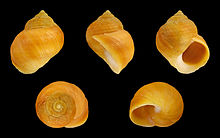Rough periwinkle
| Rough periwinkle | |
|---|---|
 |
|
| A shell of Littorina saxatilis | |
| Scientific classification | |
| Kingdom: | Animalia |
| Phylum: | Mollusca |
| Class: | Gastropoda |
| (unranked): | clade Caenogastropoda clade Hypsogastropoda clade Littorinimorpha |
| Superfamily: | Littorinoidea |
| Family: | Littorinidae |
| Genus: | Littorina |
| Species: | Littorina saxatilis |
| Binomial name | |
|
Littorina saxatilis (Olivi, 1792) |
|
| External identifiers for Littorina saxatilis | |
|---|---|
| Encyclopedia of Life | 619401 |
| GBIF | 13714421 |
| ITIS | 70405 |
| NCBI | 31220 |
| WoRMS | 140264 |
| Also found in: | |
Littorina saxatilis, common name the rough periwinkle, is a species of small sea snail, a marine gastropod mollusc in the family Littorinidae, the winkles or periwinkles. First identified in the 1700s, it has been misidentified as a new species 112 times.
This species is native to the shores of the North Atlantic Ocean, including Hudson Bay, Baffin Island, Greenland, and the Barents Sea, south along the American East Coast to Chesapeake Bay, and along the European coast to the Straits of Gibraltar.
This species has also been introduced to San Francisco Bay, on the West Coast of the United States, where it was first observed in 1992.
The shell in life often appears green with algae, but the shell itself can be white, red, or brown, sometimes with checkered lines. The shell has 4-5 whorls. Maximum recorded shell length is 19 mm.
Apertural view
Abapertural view
A series of shells of Littorina saxatilis
This species frequently lives in salt marshes. it can also be found in crevices of intertidal bedrock, in empty barnacle shells, and under rocks. Like many other periwinkles, this species can survive long exposures out of the water.
The species has been recorded alive from depth range 0 – 46 m or up to 183 m (for shells only).
In the exposed Galician coast in the Northern Spain, two well differentiated ecotypes are adapted to different shore levels and habitats. The RB ecotype (Ridged and Banded) lives on barnacles in the upper shore. This ecotype displays a larger and more robust shell to resist the attack from predators such as crabs, and a smaller shell aperture in order to reduce the desiccation due to high sunshine exposure. The SU ecotype (Smooth and Unbanded) is found at the lower shore living on mussels. This ecotype shows a smaller and thinner shell with a wider shell aperture to allocate a relatively larger muscular foot providing a higher ability to avoid the dislodgment caused by the heavy wave action. Both ecotypes coexist in an intermediate habitat at the middle shore.
...
Wikipedia
